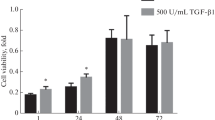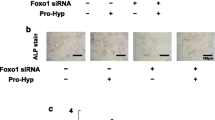Abstract
Collagens are the main components of human tissues. Various regulatory factors and cytokines may influence expression levels for collagen-encoding genes, and, therefore, contrubite to some collagen-associated pathologies. In this study, we demonstrate regulatory effects of USF1 on expression of genes encoding fibrillar collagen types I, II, and III in osteoblastic Saos-2 and MG-63 cells. An ectopic expression of the human USF1 led to a decrease in both mRNA and protein expression levels of the collagen-encoding genes mentioned above. ADAMTS-3 is a proteinase primarily responsible for the amino-terminal cleavage of type I and type II collagen precursors. The ADAMTS-3 promoter region contains potential binding sites for USF1. Here we show that an overexpression of USF1 lead to a decrease in ADAMTS-3 mRNA and protein expression levels. In co-transfection studies, USF1 negatively regulated ADAMTS-3 promoter activity. Further, in EMSA studies, we showed that USF1 binds to the ADAMTS-3 promoter region. In conclusion, it seems that ADAMTS-3 and USF1 contribute to the regulation of collagen encoding genes in osteosarcoma.



Similar content being viewed by others
REFERENCES
Baumann S., Hennet T. 2016. Collagen accumulation in osteosarcoma cells lacking GLT25D1 collagen galactosyltransferase. J. Biol. Chem. 291, 18514–18524. https://doi.org/10.1074/jbc.M116.723379
Myllyharju J., Kivirikko K.I. 2004. Collagens, modifying enzymes and their mutations in humans, flies and worms. Trends Genet. 20, 33–43. https://doi.org/10.1016/j.tig.2003.11.004
Gelse K., Poschl E., Aigner T. 2003. Collagens: Structure, function, and biosynthesis. Adv. Drug Deliv. Rev. 55 (12), 1531–1546. https://doi.org/10.1016/j.addr.2003.08.002
Von der Mark K. 1999. Structure, biosynthesis and gene regulation of collagens in cartilage and bone. In: Dynamics Bone Cartilage Metabolism. Eds. Seibel M.J., Robins S.P., Bilezikian J.P. San Diego: Academic, pp. 3–29.
Hulmes D.J., Miller A. 1981. Molecular packing in collagen. Nature. 293, 234–239. https://doi.org/10.1038/230437a0
Rossert J., de Crombrugghe B. 2002. Type I collagen: Structure, synthesis and regulation. In: Principles in Bone Biology. Eds. Bilezkian J.P., Raisz L.G., Rodan G. Orlando: Academic, pp. 189–210.
Von der Mark K. 1981. Localization of collagen types in tissues. Int. Rev. Connect. Tissue Res. 9, 265–324.
Wu D., Chen K., Bai Y., Zhu X., Chen Z., Wang C., Zhao Y., Li M. 2014. Screening of diagnostic markers for osteosarcoma. Mol. Med. Repts. 10, 2415–2420. https://doi.org/10.3892/mmr.2014.2546
Pratap J., Galindo M., Zaidi S.K., Vradii D., Bhat B.M., Robinson J.A., Choi J.Y., Komori T., Stein J.L., Lian J.B., Stein G.S., van Wijnen A.J. 2003. Cell growth regulatory role of Runx2 during proliferative expansion of preosteoblasts. Cancer Res. 63 (17), 5357–5362.
Thomas D.M., Johnson S.A., Sims N.A., Trivett M.K., Slavin J.L., Rubin B.P., Waring P., McArthur G.A., Walkley C.R., Holloway A.J., Diyagama D., Grim J.E., Clurman B.E., Bowtell D.D., Lee J.S., et al. 2004. Terminal osteoblast differentiation, mediated by runx2 and p27KIP1, is disrupted in osteosarcoma. J. Cell Biol. 167 (5), 925–934. https://doi.org/10.1083/jcb.200409187
Thomas D.M., Carty S.A., Piscopo D.M., Lee J.S., Wang W.F., Forrester W.C., Hinds P.W. 2001. The retinoblastoma protein acts as a transcriptional coactivator required for osteogenic differentiation. Mol. Cell. 8, 303–316. https://doi.org/10.1016/S1097-2765(01)00327-6
Mignatti P., Rifkin D.B. 1993. Biology and biochemistry of proteinases in tumor invasion. Physiol. Rev. 73, 161–195.https://doi.org/10.1152/physrev.1993.73.1.161
Holmbeck K., Bianco P., Caterina J., Yamada S., Kromer M., Kuznetsov S.A., Mankani M., Robey P.G., Poole A.R., Pidoux I., Ward J.M., Birkedal-Hansen H. 1999. MT1-MMP-deficient mice develop dwarfism, osteopenia, arthritis, and connective tissue disease due to inadequate collagen turnover. Cell. 99, 81–92.
Makareeva E., Han S., Vera J.C., Sackett D.L., Holmbeck K., Phillips C.L., Visse R., Nagase H., Leikin S. 2010. Carcinomas contain a matrix metalloproteinase-resistant isoform of type I collagen exerting selective support to invasion. Cancer Res. 70 (11), 4366–4374. https://doi.org/10.1158/0008-5472
Yong H.Y., Moon A. 2007. Roles of calcium-binding proteins, S100A8 and S100A9, in invasive phenotype of human gastric cancer cells. Arch. Pharm. Res. 30, 75–81.
Chen P.N., Kuo W.H., Chiang C.L, Chiou H.L., Hsieh Y.S., Chu S.C. 2006. Black rice anthocyanins inhibit cancer cells invasion via repressions of MMPs and u-PA expression. Chem.-Biol. Interact. 163, 218–229. https://doi.org/10.1016/j.cbi.2006.08.003
Nabha S.M., dos Santos E.B., Yamamoto H.A., Belizi A., Dong Z., Meng H., Saliganan A., Sabbota A., Bonfil R.D., Cher M.L. 2008. Bone marrow stromal cells enhance prostate cancer cell invasion through type I collagen in an MMP-12 dependent manner. Int. J. Cancer. 122 (11), 2482–2490. https://doi.org/10.1002/ijc.23431
Mori K., Enokida H., Kagara I., Kawakami K., Chiyomaru T., Tatarano S., Kawahara K., Nishiyama K., Seki N., Nakagawa M. 2009. CpG hypermethylation of collagen type I α 2 contributes to proliferation and migration activity of human bladder cancer. Int. J. Oncol. 34, 1593–1602. https://doi.org/10.3892/ijo_00000289
Rippe R.A., Umezawa A., Kimball J.P., Breindl M., Brenner D.A. 1997. Binding of upstream stimulatory factor to an E-box in the 3′-flanking region stimulates a1(I) collagen gene transcription. J. Biol. Chem. 272 (3), 1753–1760.
Datta T.K., Rajput S.K., Wee G., Lee K., Folger J.K., Smith G.W. 2015. Requirement of the transcription factor USF1 in bovine oocyte and early embryonic development. Reproduction. 149, 203–212.
Goldring M.B., Sandell L.J. 2007. Transcriptional control of chondrocyte gene expression. In: Osteoarthritis, Inflammation Degradation: A Continuum. Eds. Buckwalter J.A., Lotz M., Stoltz J.F. 70, 118–142.
Aydemir T.A., Alper M., Kockar F. 2018. SP-1 mediated downregulation of ADAMTS3 gene expression in osteosarcoma models. Gene. 659, 1–10.
Kockar F.T., Foka P., Hughes T.R., Kousteni S., Ramji D.P. 2001. Analysis of the Xenopus laevis CCAAT-enhancer binding protein alpha gene promoter demonstrates species-specific differences in the mechanisms for both autoactivation and regulation by Sp1. Nucleic Acids Res. 29, 362–372.
Alper M., Kockar F. 2014. IL-6 upregulates a disintegrin and metalloproteinase with thrombospondin motifs 2 (ADAMTS-2) in human osteosarcoma cells mediated by JNK pathway. Mol. Cell. Biochem. 393, 165–175.
Livak K.J., Schmittgen T.D. 2001. Analysis of relative gene expression data using real-time quantitative PCR and the 2(–DeltaDeltaC(T) method. Methods. 25 (4), 402–408.
Tokay E., Kockar F. (2016. Identification of intracellular pathways through which TGF-β1 upregulates URG-4/URGCP gene expression in hepatoma cells. Life Sci. 144, 121–128. https://doi.org/10.1016/j.lfs.2015.12.010
Schneider C.A., Rasband W.S., Eliceiri K.W. 2012. NIH image to image: 25 years of image analysis. Nat. Methods. 9, 671–675.
Quandt K., Frech K., Karas H., Wingender E., Werner T. 1995. MatInd and MatInspector: New fast and versatile tools for detection of consensus matches in nucleotide sequence data. Nucleic Acids Res. 23, 4878–4884.
Cartharius K., Grote K., Klocke B., Haltmeier M., Klingenhoff A., Frisch M., Bayerlein M., Werner T. 2005. MatInspector and beyond: Promoter analysis based on transcription factor binding sites. Bioinformatics. 21, 2933–2942. https://doi.org/10.1093/bioinformatics/bti473
Kiermaier A., Gawn J.M., Desbarats L., Saffrich R., Ansorge W., Farrell P.J., Eilers M., Packham G. 1999. DNA binding of USF is required for specific E-box dependent gene activation in vivo. Oncogene. 18 (51), 7200–7211. https://doi.org/10.1038/sj.onc.1203166
Qyang Y., Luo X., Lu T., Ismail P.M., Krylov D., Vinson C., Sawadogo M. 1999. Cell-type dependent activity of the ubiquitous transcription factor USF in cellular proliferation and transcriptional activation. Mol. Cell. Biol. 19 (2), 1508–1517.
Yasuda H., Oh C., Chen D., Crombrugghe B., Kim J.H. 2017. A novel regulatory mechanism of type II collagen expression via a SOX9-dependent enhancer in intron 6. J. Biol. Chem. 292 (2), 528–538. https://doi.org/10.1074/jbc.M116.758425
Otero M., Peng H., Hachem K.E., Culley K.L., Wondimu E.B., Quinn J., Asahara H., Tsuchimochi K., Ko Hashimoto K., Goldring M.B. 2017. ELF3 modulates type II collagen gene (COL2A1) transcription in chondrocytes by inhibiting SOX9-CBP/p300-driven histone acetyltransferase activity. Connect. Tissue Res. 58 (1), 15–26. https://doi.org/10.1080/03008207.(2016)1200566
Riquet F.B., Tan L., Choy B.K., Osaki M., Karsenty G., Osborne T.F., Auron P.E., Goldring M.B. 2001. YY1 is a positive regulator of transcription of the Col1a1 gene. J. Biol. Chem. 276 (42), 38665–38672.
Le Goff C., Somerville R.P., Kesteloot F., Powell K., Birk D.E., Colige A.C., Apte S.S. 2006. Regulation of procollagen amino-propeptide processing during mouse embryogenesis by specialization of homologous ADAMTS proteases: Insights on collagen biosynthesis and dermatosparaxis. Development. 133 (8), 1587–1596.
Pautke C., Schieker M., Tischer T., Kolk A., Neth P., Mutschler W., Milz S. 2004. Characterization of osteosarcoma cell lines MG63, Saos-2 and U-2 OS in comparison to human osteoblasts. Anticancer Res. 24, 3743–3748.
Fernandes R.J., Harkey M.A., Weis M., Askew J.W., Eyre D.R. 2007. The post-translational phenotype of collagen synthesized by Saos-2 osteosarcoma cells. Bone. 40 (5), 1343–1351.
ACKNOWLEDGMENTS
Saos-2 cells and USF1 expression plasmid were kindly provided by Dr. Kenneth Wann and by Dr. Dipak P. RAMJI (Cardiff, School of Biosciences, Cardiff UK), respectively. MG-63 cells were kindly provided by Dr. Berivan ÇEÇEN, (Dokuzeylül University, Izmir, TURKEY).
Funding
This work was supported by the Scientific and Technological Research Council of Turkey (TUBITAK), Project number; 114Z025.
Author information
Authors and Affiliations
Corresponding author
Ethics declarations
COMPLIANCE WITH ETHICAL STANDARDS
Authors declare no competing interests. The article contains no research in which animals were used.
ADDITIONAL INFORMATION
The text was submitted by the authors in English.
Rights and permissions
About this article
Cite this article
Alper, M., Aydemir, T. & Köçkar, F. USF1 Suppresses Expression of Fibrillar Type I, II, and III Collagen and pNP Adamts-3 in Osteosarcoma Cells. Mol Biol 55, 580–588 (2021). https://doi.org/10.1134/S0026893321030031
Received:
Revised:
Accepted:
Published:
Issue Date:
DOI: https://doi.org/10.1134/S0026893321030031




